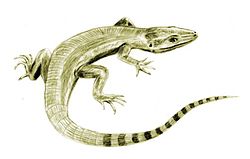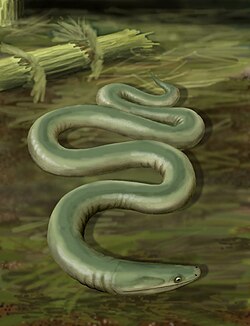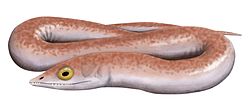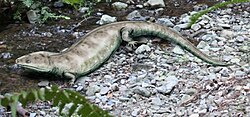Stratigraphy
In Pennsylvania, the Allegheny Group includes rocks from the base of the Brooksville Coal to the top of the Upper Freeport Coal, and was defined to include all economically significant coals in the upper Pennsylvanian sequence. [4] The unit consists of cyclothemic sequences of coal, shale, limestone, sandstone, and clay. It contains six major coal zones, which, in stratigraphic order, are:
- Upper Freeport Coal
- Lower Freeport Coal
- Upper Kittanning Coal
- Middle Kittanning Coal
- Lower Kittanning Coal
- Brookville Coal
Members
Glen Richey (PA), Laurel Run (PA), Mineral Springs (PA), Millstone Run (PA), Clearfield Creek (PA); Clarion (OH, MD, PA, WV), Kittanning (PA), Freeport (PA, MD, OH, WV); Putnam Hill (OH, PA); Vanport (PA, MD, OH, WV); Butler (MD, PA), Worthington (MD, PA); Washingtonville (OH, PA, WV), Columbiana (OH) [5]
Age
Relative age dating of the Allegheny places it about mid-way through the Pennsylvanian, the second subperiod of the Carboniferous period. The plant and conchostracan fossils in particular can be equated with European strata of the "Asturian" (Westphalian D) regional stage. In North America, the roughly equivalent regional stage is known as the Desmoinesian. [2] The Asturian has an estimated age of 310.7 to 307.5 million years ago (Ma), equivalent to the latter half of the global Moscovian stage. [6]
Notable sites
The Allegheny Group has the richest fauna of tetrapod fossils in the entire Appalachian Basin, and practically all of these fossils are concentrated at the Linton site of Ohio. [7] [8]
Linton was once a tiny village at the mouth of Yellow Creek (Saline Township) in Jefferson County. The nearby Diamond Coal Mine was active from 1855 to 1892, and again from 1917 to 1921, when the drift mine was permanently closed. The drift mine collapsed soon afterwards and the settlement diminished into obscurity. The main Diamond coal seam is likely equivalent to the Upper Freeport coal. John S. Newberry, from Columbia University and Chief Geologist of the Geological Survey of Ohio, was the first paleontologist to investigate the Linton area. [9] Starting in 1856, he collected thousands of fossils from the mine. Under the stewardship of E.D. Cope, some of Newberry's fossils were transferred to the American Museum of Natural History (AMNH), and others to the Orton Geological Museum at The Ohio State University. Other 19th-century geologists who collected fossils from the site include Frank Howe Bradley (1865, on behalf of Yale), R. N. Fearon (1883, Harvard), and Thomas Stock (1888, British Museum and the National Museum of Natural History). Fossil collection extended into the 20th century, with expeditions led by Jesse Hyde (AMNH), A.S. Romer (Field Museum), Donald Baird (Harvard, Princeton), Richard Lund and David Hamilla (Carnegie). Over 7000 Linton fossils are now in the collections of at least 14 museums across three countries. [7] [8]
A second fossiliferous site is Five Points, a similar coal deposit in Beaver Township of Mahoning County. The Five Points cannel coal mine was first publicized as a fossil site by Robert Hook and Donald Baird in 1994, who collected tetrapod fossils comparable to those found at Linton. However, the mine at Five Points was reclaimed around the same time, so the fossiliferous spoil piles are no longer accessible for further collection. [10] [11]
Paleobiota
Tetrapod records from Hook & Baird (1986/1988) [7] [8] unless stated otherwise:
Other amphibians
Various indeterminate embolomere fossils are known from the fossil sites of the Allegheny Group, including an articulated tail from Five Points, [19] an eogyrinid-like skull roof from Linton, [20] and archeriid-like cranial and postcranial fragments from both Linton and Five Points. [21]
Invertebrates
Marine fossils in the Allegheny Group are concentrated into only a few patchy bands of limestone and shale. Four marine members (Putnam Hill, Vanport, Columbiana, and Washingtonville) have produced a rich fauna of cephalopod fossils, the best representation of the Desmoinesian stage in the Appalachian region. [22] [23] [24]
In terrestrial sediments, the Allegheny Group preserves characteristic Desmoinesian index fossils of conchostracans (bivalved crustaceans). Conchostracan species in the unit belong to an assemblage zone distinguished by Anomalonema reumauxi , Pseudestheria simoni , and potentially Palaeolimnadiopsis freysteini . [25] [26] Invertebrate fossils from Linton include 'spirorbid' tubes, ostracods, syncarid crustaceans, and millipedes ( Xyloiulus bairdi , Plagiascetus lateralis , and other undescribed species). [27] [8] Some groups (insects, arachnids, and freshwater bivalves) are curiously absent from Linton. [8]
This page is based on this
Wikipedia article Text is available under the
CC BY-SA 4.0 license; additional terms may apply.
Images, videos and audio are available under their respective licenses.
















